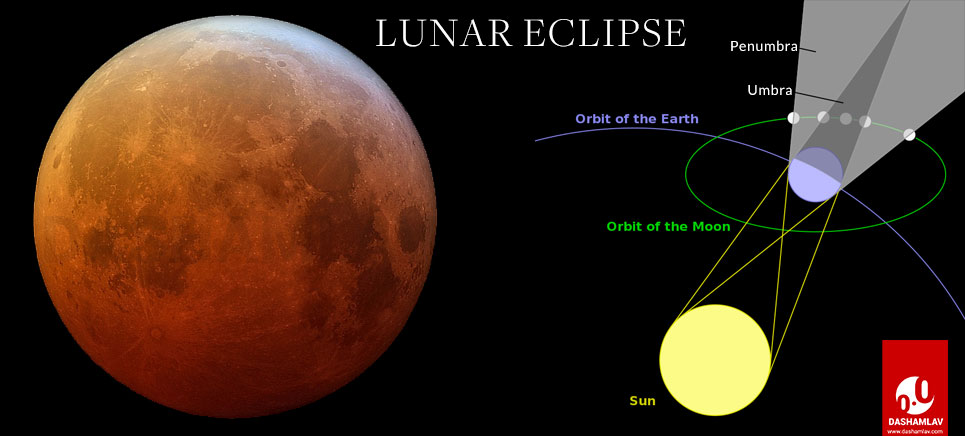Lunar Eclipse occurs when Earth’s shadow engulfs the Moon. During the lunar eclipse, the Sun, Earth and the Moon gets aligned and Earth blocks sunlight from reaching the lunar surface. From Earth, we can see Earth’s shadow obscuring the lunar disc. The lunar eclipse is a perfectly normal, fully explicable natural phenomenon. However, in many cultures around the world superstitions have been associated with the occurrence of lunar eclipse as well as solar eclipse. In this article we are listing a few interesting and surprising facts about the lunar eclipse. These facts will help you understand the mechanism of such eclipses.
1. Duration of Total Lunar Eclipse
While a total solar eclipse can not last for more than a few minutes, the total lunar eclipse can last for 1 hour and 47 minutes at a given location on Earth. This difference is simply because the Moon casts a much smaller shadow on Earth during solar eclipse.
2. Visibility of Lunar Eclipse
A lunar eclipse can been seen from any location on the night side of the Earth. This is in contrast to the fact that solar eclipse is visible only from a limited area in the day side of the Earth. Therefore, more people can view lunar eclipse than the solar eclipse.
3. Viewing Lunar Eclipse is Safe
Moon appears bright only because its surface reflects the sunlight. The intensity of this reflected sunlight is much lesser than the direct light that we get from the Sun. While looking directly at solar eclipse can be harmful for the eyes, lunar eclipse is perfectly safe for such viewing.
4. Blood Moon
Sometimes, during the total lunar eclipse, the Moon’s disc appear reddish in color. This red appearance of the totally eclipsed Moon is called the Blood Moon. This red color comes from the sunlight refracted by the Earth’s atmosphere. From the refracted light only red portion reaches to us due to Rayleigh scattering of bluer light.

5. Types of Lunar Eclipse
There are three types of lunar eclipses:
- Penumbral Lunar Eclipse: Moon passes only through penumbral shadow of the Earth. Such lunar eclipses are subtle and hard to notice. These are mostly of the academic interest — general public often does not come to know about these.
- Partial Lunar Eclipse: Only a part of the Moon passes through Earth’s umbral shadow.
- Total Lunar Eclipse: The whole Moon passes through the umbral shadow of Earth. Totality is the period when Moon is in total eclipse.
6. Frequency of Lunar Eclipses
There will be 230 lunar eclipses in the 21st century (2000–2100): 87 penumbral, 58 partial and 85 total. This mean that we will have 2.3 lunar eclipse every year in this century.
7. Selenelion or Selenehelion
Selenelion occurs when both the Sun and the eclipsed Moon is visible from the Earth. This rare celestial event happens only around sunset or sunrise. Both the Sun and the eclipsed Moon will appear just above the horizon in the opposite directions in sky.
8. Temperature Drops of the Moon
During the lunar eclipse the temperature on Moon drops drastically. Earth’s shadow blocks all the sunlight falling on Moon’s surface and causes the temperature to plummet within minutes.
In 1971, during a total lunar eclipse, temperature at the Apollo 12 landing site on the Moon dropped from 168.3 ºF (75.7 ºC) to minus 153 ºF (minus 102.7 ºC) — a change of 321.3 degrees!
9. Longest Total Lunar Eclipse
In theory, a total lunar eclipse can only last for 1 hour and 47 minutes. The longest total lunar eclipse on record lasted for 1 hour and 46.4 minutes. This total lunar eclipse occurred on 16 July 2000.
10. Dates of Upcoming Lunar Eclipses
- 2021 May 26 (Total Lunar Eclipse)
- 2021 Nov 19 (Partial Lunar Eclipse)
- 2022 May 16 (Total Lunar Eclipse)
- 2022 Nov 08 (Total Lunar Eclipse)
- 2023 May 05 (Penumbral Lunar Eclipse)
- 2023 Oct 28 (Partial Lunar Eclipse)
Use the citation below to add this article to your bibliography
"Lunar Eclipse: Definition, Facts, Myths, Types, Dates and Diagrams." Dashamlav.com. Web. 27 July 2024. <https://dashamlav.com/lunar-eclipse-definition-facts-myths-types-dates-diagrams/>
Dashamlav.com, "Lunar Eclipse: Definition, Facts, Myths, Types, Dates and Diagrams." Accessed 27 July 2024. https://dashamlav.com/lunar-eclipse-definition-facts-myths-types-dates-diagrams/
"Lunar Eclipse: Definition, Facts, Myths, Types, Dates and Diagrams." (n.d.). Dashamlav.com. Retrieved 27 July 2024 from https://dashamlav.com/lunar-eclipse-definition-facts-myths-types-dates-diagrams/
